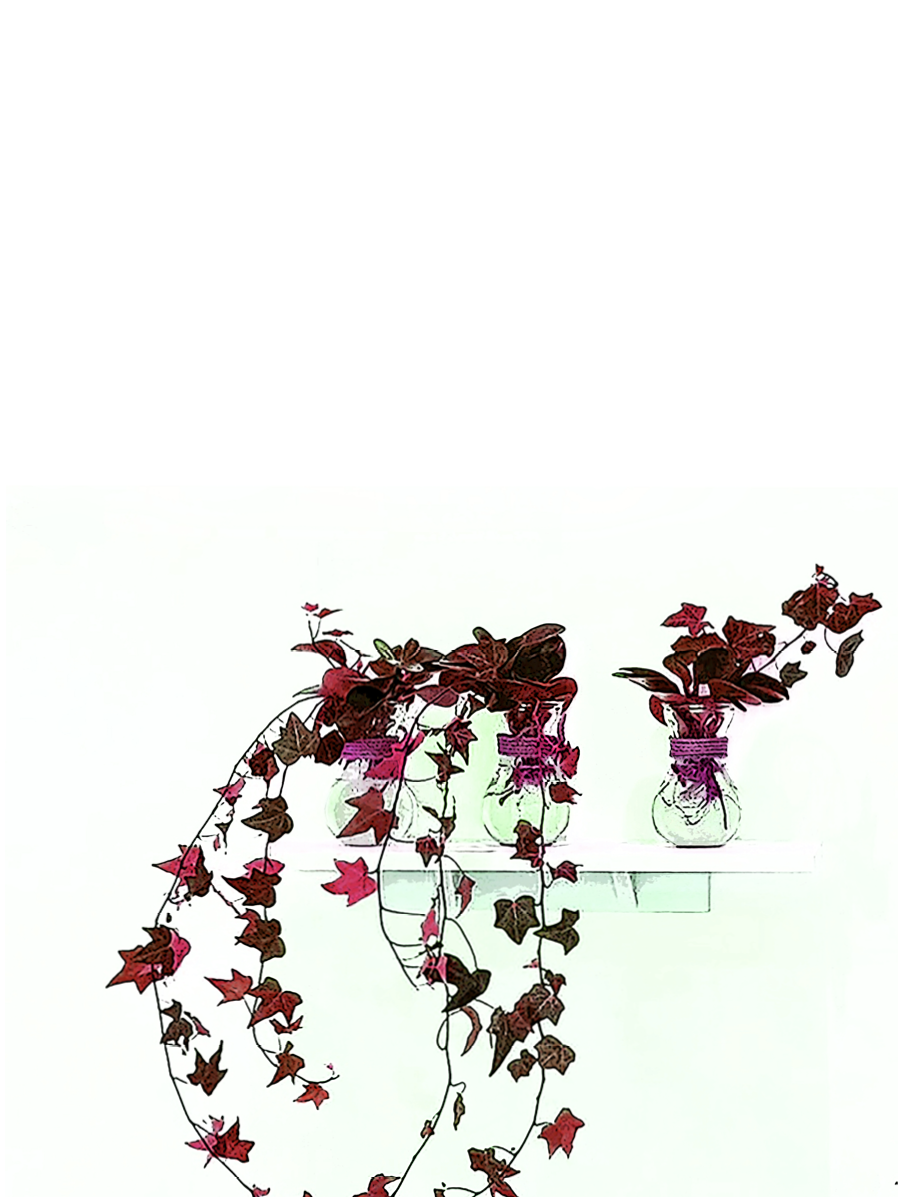
Minjie Wen
Plant Intelligence in Moist Spaces: Designing Data Visualisations of Botanical Life

ABSTRACT
At the beginning of the twenty-first century, when the life sciences and computer science were in full bloom, new media practices based on computer technology were being integrated into living systems, for which new media artist Roy Ascott proposed the concept of ‘moist media’ – a medium born from the intersection of dry digital media and moist biological systems. This reflection on creative practice takes moist media as the context, plants as the medium, and botanical life as the research context. My digital art depicts the life phenomena of plants through data visualisation to explore the practical value of plants as creative media. The form, technology, and thematic elements of data visualisation of life can work together in the context of moist media to expand the space of communication between humans and plants.
KEYWORDS
moist media, data visualisation, plant intelligence, bio-art
 he presence of moist media as a context
he presence of moist media as a context
New media artist Roy Ascott introduced the concept of ‘moist media’ at the beginning of the twenty-first century to refer to ‘the fusion of dry digital media and moist biological systems’.1 The moistness of the medium is not the same as its purely biological nature but goes beyond the exclusivity of the medium to reveal a hybrid mode of existence and a blurring of the line between the digital and the biological. In the context of ‘dry’ silicon-crystalline computer technology combined with ‘moist’ living systems, ‘moist media’ is used by artists to explore infinite possibilities for creative expression. Artists have also shifted from single-media to interdisciplinary expression and have begun to explore the dichotomy between humans and nature, technology and biology, through the use of moist media, triggering new ideas concerning the ontology of art. The rapid development of biological sciences has deepened our understanding of the value of life. Bio-artists attempt to communicate with living creatures through spontaneous communication from the creatures themselves.2
Life in the context of moist media: from materiality to process
Presentation of the subjectivity of life
One of the characteristics of moist-media creations is the blurring of the boundaries between living beings and machines, living and non-living beings, and natural and human-made objects. Life evolves following the laws of nature. With the development of digital technology and biological sciences, living beings such as animals and plants are becoming the subjects of artistic creation in moist-media creation, capable of being ‘unnaturalised’ and reconstructed through specific techniques.3
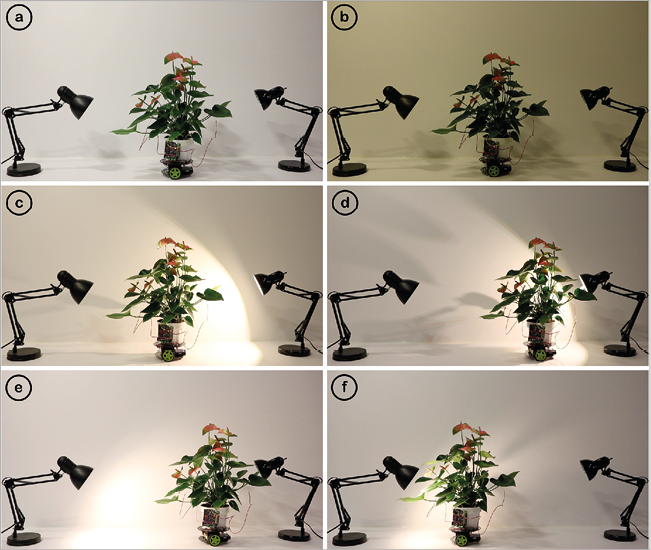
FIGURE 1.
Elowan: A plant-robot hybrid, 2018.
Source: MIT media lab/ Harpreet Sareen. License: CC-BY 4.0
Elowan (Figure 1), a project in the MIT Media Lab Fluid Interfaces, is a plant-machine hybrid (Elowan: A plant-robot hybrid).4 Elowan is a form of controlled life, a plant that talks directly to machines. The plant uses its internal electrical signals to connect with the robot’s extensions and drive them into the light. The project uses plants as electroactive systems. They are electrochemically excited to conduct signals between tissues and organs. This electrical signalling is generated in response to changes in light, gravity, mechanical stimuli, temperature, trauma and other environmental conditions.
Hong Kong academic Wang-Chak Chan has looked at cellular automata algorithms and optimised them. In 2015, he developed an artificial life system called ‘Lenia’,5 a model that can evolve a variety of life forms, with different kinds of organisms having very different forms, habits and movements. These digital organisms have the basic functions of a living organism: self-organisation, repair, metabolism and response to the external environment. So far, more than 400 species in eighteen families have been identified in the ecosystems formed by Lenia. Other cellular automata models in this project differ in that they are geometric, metadata-driven, fuzzy, resilient, adaptive and rule-generating.
In its exploration of life, biology shifts its focus from biological materiality (cells, proteins) to the processual nature of life (behaviour), and the discussion focuses on machine life. Discussions of how life emerges from machine structure, the behaviour of digitally mediated simulations of life and the restoration of biological perception through human-made materials all fall within the realm of moist media. The absence of biological media in the latest presentation of moist-media works is gradually directing our attention to living things from biological materiality (cells, proteins) to life processuality (behaviour).
Life is being mediatised
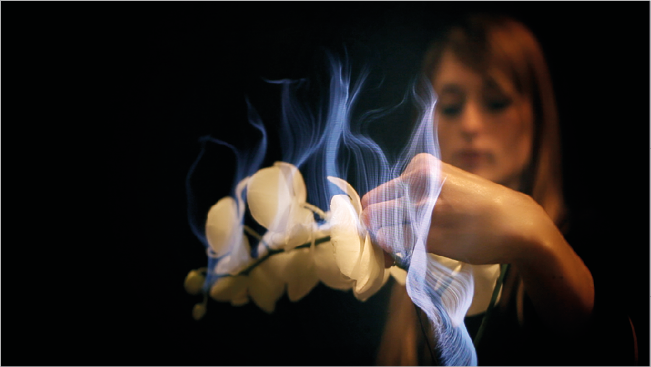
FIGURE 2.
Botanicus Interacticus. New modes of interaction between humans and living plants, 2012.
Source: Munehiko Sato, with kind permission: https://satomunehiko.com/works/botanicus-interacticus/
Dr. Ivan Poupyrev, working at Disney Research, collaborated with Jonas Loh from Studio NAND, Philipp Schoessler and Munehiko Sato to develop Botanicus Interactions (Figure 2), where they invented a new capacitive touch sensor. It creates an electromagnetic field around an object and measures tiny perturbations in that field. By equipping humans and plants with rich touch and gesture sensitivity, new modes of interaction between humans and living plants are explored. It allows for rich and expressive interactions with plants. Depending on the physiology of each plant species, a wide variety of gestures can be allowed, such as sliding a finger over a plant stem, detecting touch and grip positions, tracking the proximity between the user and the plant, and estimating the amount of touch.
The Austrian-French artist duo Christa Sommerer and Laurent Mignonneau exhibited Interactive Plant Growing (Figure 3) at ZKM in the exhibition ‘The Work of Art as a Living System’. The work simulates a living system in which real plants come into contact with or move in front of a screen to produce transformations in digital space, using algorithms that depict not only the form of the living organisms but also their evolution and growth. The technological devices designed by the artists produce virtual realities and immersive environments beyond the scope of previous experiences. Their work has become almost a classic of plant-based digital art, opening up new horizons for art to function as a living system.
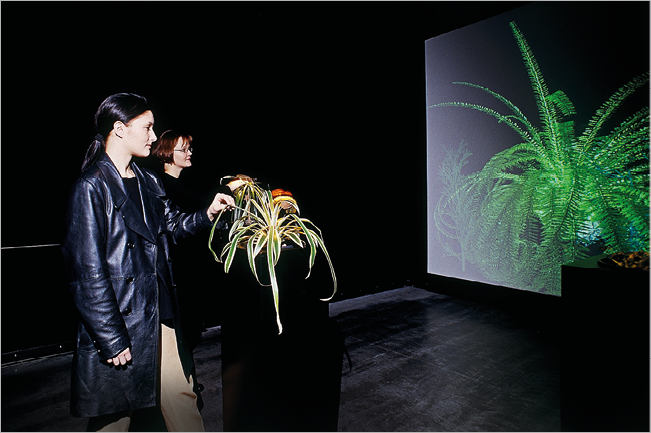
FIGURE 3.
Interactive Plant Growing , Christa Sommerer and Laurent Mignonneau, 1992.
Source: Photo © ZKM | Center for Art and Media, Photo: ONUK. By kind permission of the artists. https://zkm.de/en/artwork/interactive-plant-growing
The French philosopher Simondon describes the technological object as a part of human nature that has evolved through ‘concretisation’, thus emphasising the relationship between the object and its environment, which develops through mutual adaptation in an ongoing dialogue. Although we have already experienced the integration of machines and humans, the integration of technology into ecosystems is a concept that has yet to be realised. The highly developed sensory system that plants possess provides an opportunity for this. At the same time, plants can supply, regenerate themselves, emit and receive positive signals from the web. This is largely in line with the self-sustaining function that machines have always wanted to have. The artist therefore begins to think about how to create new symbiotic relationships, thus combining technological developments with our ecology on a more practical level, and then begins to explore the symbiotic and co-operative relationship between plants and machines.
Data visualisation practices for plant life phenomena
Based on Roy Ascott’s view of ‘moist Media’, The Light Humour of Plants explores organic life systems as they manifest in virtual digital environments, drawing on the idea that the fusion of organic life-forms and machinery makes mechanical synthetic objects life-like and that organic life (such as the human body, plants, and cells) becomes more constructed and designed.6 In short, this work is a dual-media expression of the ‘life’ of dry media and the ‘existence’ of living beings in the context of moist media.
The blend of dryness, representing the precision and structure of digital technology, with moistness, symbolising the organic and living aspects of biological systems, is indeed a fitting metaphorical proposition for the contemporary era. When we keep proposing cyborgs and cyberspace, I would also like to know if we can also have cyborg plants and plant intelligence. Therefore, my work explores nature and technology, life and non-life, in moist space. My works reflects on the close relationship between human activities and nature while observing the boundaries between organisms and machines, between natural and human-made objects.7 The Light Humour of Plants (Figure 4) is my exploration of these issues, as well as the representation of organic living systems in a virtual digital environment. At the same time, the work also explores the tangible interactions between nature, data and humans.
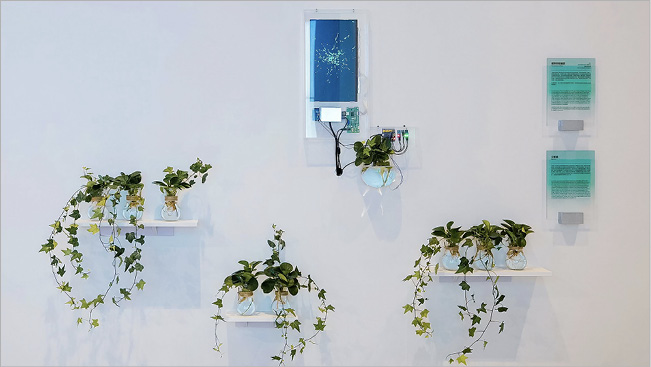
Figure 4.
Light humor of plants, exhibition site, 2023.
Source: Photo by author.
For this work, I seamlessly integrated a real-world plant’s living system into a virtual digital environment, establishing a sensing system within the plant. This system relays the data gathered by the plant to the digital realm, where it is subsequently transformed into a visual representation. The work is designed in parallel on the virtual and physical levels.
Virtual level: This level is invisible to the visitor and constitutes the system architecture of the work that performs data collection, processing and visualisation in the background. The system architecture is further divided into two subsystems: the collection and processing system and the visualisation system (Figure 5). All types of data that will be acquired at the virtual space level are processed, visualised and presented in real-time at the physical space level, creating an intrinsic link between the physical and the virtual. The visual content is continuously changed based on the real-time data.

Figure 5.
Light humor of plants, Virtual Level Design, 2023.
Source: Drawn by the author.
Physical level: the physical spatial level includes the space around the work as well as the technical components that themselves perform the data visualisation output (Figure 6). These components include the 15.6 display and its customised enclosure, the Arduino hardware device, the sound and so on, which are used to convey the audio and video content. Their form and position are rationalised by design into the physical space in which the work is located, carrying much of the aesthetic quality of the work and providing a hybrid spatial experience.

Figure 6.
Light humor of plants, Physical Level Design, 2023.
Source: Drawn by the author.
All the elements of the physical and virtual layers come together to form the artwork The Light Humour of Plant. Changes in the environment around the plant contribute to the collection of data, which is integrated and eventually fed back into the overall art as part of the visualisation. The viewer who stays and gazes at the artwork can also interact with specific components of the artwork to change its form.
Environmental elements
Plants can perceive changes in the environmental data around themselves – environmental elements in the work refer to the visualisation of the four types of external data that affect the growth of life, namely temperature, humidity, carbon dioxide, and light, which are transformed into factors affecting the vision. In this work the four types of data are used to map in Touch Designer animation (Figure 7), to find the most matching data variables. The real-time data will have a real-time impact on the animation, and, when the participants watch the animation, they will be affected by the visual effects of the changing elements in real-time, feel the changes in the spatial environment that the plants are in and experience the changes in the subtle elements of the world that the plants feel.

Figure 7.
Light humor of plants, Animation Run Logic Diagram, 2023.
Source: Created by the author.
In terms of mapping environmental factors to the representation of the work, temperature, humidity, carbon dioxide and light intensity have all been assigned corresponding visual representations or ‘Data Mapping’. Specifically, temperature relates to particle colour and humidity relates to the degree of penetration, often referred to as diffusion. When a person approaches a plant installation, they exhale carbon dioxide, which increases the carbon dioxide concentration in the vicinity. An increase in carbon dioxide concentration correlates with an increase in the number of particles detected. Similarly, light intensity corresponds to particle size – the greater the light intensity, the larger the particles (Figure 8).

Figure 8.
Light humor of plants, Data Mapping, 2023.
Source: Drawn by the author.
Humidity and diffusion: humidity levels significantly affect the diffusion process, which in turn is directly related to the extent and speed at which particles travel through the environment.
Carbon dioxide concentration and particle number: as the carbon dioxide concentration increases, the number of detected particles increases accordingly, which clearly reveals a direct positive correlation between the two.
Light intensity and particle size: in visual representations, there is an intuitive link between light intensity and particle size, usually showing that the higher the light intensity, the larger the mapped particles.
Temperature and colour: an increase in temperature is often accompanied by a warming of colour, from cool to warm tones, providing an intuitive perception of temperature.
This ‘data mapping’ approach provides a dynamic and interactive visual experience that translates subtle environmental changes into a more tangible and interpretable form for the audience.
Living systems design
The life element within the artwork captures the life phenomena of the plant, demonstrating a state that remains invariant despite fluctuations in external data. Utilising the L-system algorithm, the artwork autonomously generates a visualisation that encapsulates the plant’s life cycle. This presentation dynamically illustrates the continuous transformation of the plant’s three primary life states: cell division, growth and differentiation. In the animation to simulate the production of its three states (Figure 9), life starts from a single cell. Life begins with a single cell, gradually increases in size, divides and repeats this process over and over again. When the volume reaches a certain limit, it begins to differentiate morphologically, which is also a manifestation of evolution.

Figure 9.
Light humor of plants, Model 1 Naturally Data Driven, 2023.
Source: Drawn by the author.
Interactive elements
The interactive element appears in the case of human interaction, where the participant touches the plant or container, and the individual plant, as a capacitive sensor, senses the human’s touch and switches animation, such that the life animation in the case of uninteracted action is transformed into a human-centered agglomerative animation, where life elements are attracted by the human, and the animation is transformed from disordered animation to ordered. The life elements are attracted by the human, from a disordered animation to an ordered animation; life becomes a product of human discipline, some particles are still struggling and escaping, but most of the existing life elements have already changed into the form of human intervention. The data visualisation still influences the data of the animation, the data of the environment still influences the animation, and the human and the environment together constitute a change in the interactive elements.
Plants are natural sensors and extremely sensitive to all forms of energy flow. Whereas our bodies constantly produce electrostatic energy, this energy cannot be sensed. Plants respond to different touches by producing changes in their data. When a person touches a plant, invisible electrostatic energy acts on the plant leaves and prompts them to respond (Figure 10).
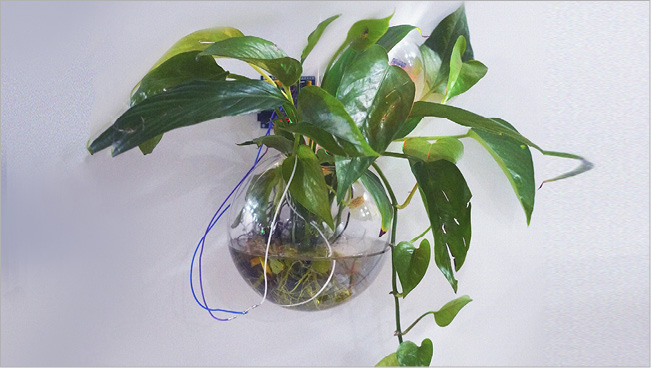
Figure 10.
Light humor of plants, exhibition site, 2023.
Source: Photo by the author.
Participants can feel the ‘language’ of the plant’s feedback when interacting (Figure 11), and the life forms generated by the work’s L-system algorithm are real-time visual reproductions of the plant’s data. The system of reproduction gives the plant the ability to ‘speak’. From the physical dimension, the work’s ready link, real-time feedback, and constant online presence constitute a sense of presence with the viewer’s mind and body. The relationship between the work and the audience is not only one of seeing and being seen but also a ‘two-way exchange’ of information, a process of culture and meaning-making. Through the encoding and decoding of plant data, there is a meaningful exchange and negotiation between the viewer and the plant.
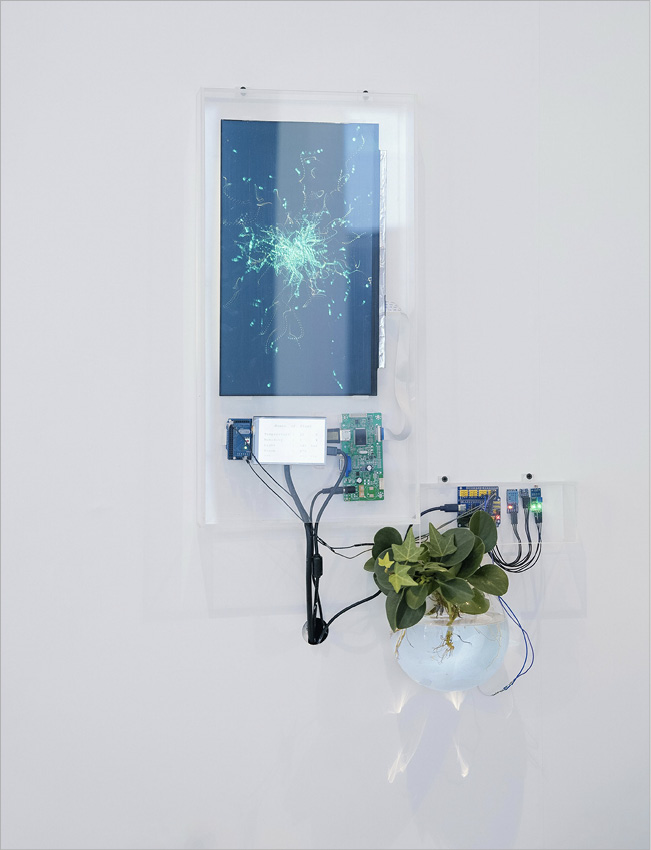
Figure 11.
Light humor of plants, exhibition site, 2023.
Source: Photo by the author.
In the process of communication, the audience will not only experience sensory feedback such as touch, hearing and sight, but will also be able to produce emotional communication in the true sense, and realise that plants have intelligence as well as ‘feelings’.
Conclusion
Scientific and technological innovations have contributed to the development of new media, and moist media is based on biology and technology. The existence of moist media combines living organisms and computer technology, and utilises the expression of new media art to expand it from purely virtual space to moist space. The rise of moist media in new media art has broken through the boundaries of media itself, giving media and new media art unprecedented vitality, and challenging the traditional concept of art. The concept of moist media is changing the public’s basic understanding of the concept of life.
The twenty-first century is heralded as the age of biology, characterised by a future that is notably ‘moist’ – a term that contrasts with the dry precision of software and hardware. The quintessential distinction of moist components lies in their irreplaceable essence of life. Humanity has reached a position where human life form and personality are no longer considered the sole vanguard of innovation and progress. Life has become the concept of creation, based on nature, combining bio-engineering and science and technology; and contemporary new media art presents more new pictures of creation. With artists practicing in this open social and technological environment, the creation of fusions of technology and art will continue to have a meaningful role in the collision between the artist, the audience and the artwork – this process is the combination of human and human, biology and technology. In today’s increasingly technological art forms, there is a potential connection between human and organic life, and there are infinite possibilities in the space of future communication.
ACKNOWLEDGEMENTS
This research was supported by ‘The Fundamental Research Funds for the Central Universities’ (2023CXZZ115). I would like to express my sincere gratitude to the reviewers for their careful review of my manuscript and for their many insightful and constructive suggestions. In addition, I would like to thank the editors for their careful consideration and valuable comments throughout the review process. Their contributions were invaluable to the writing and presentation of this paper.
Wen Minjie is an ecological artist currently on an exchange visit at the State University of New York at Oswego. She is a Master’s student at the School of Fine Arts, Central China Normal University (MFA in progress), and holds a Bachelor’s degree from the same school. Her research is centred on the ecological art practices of plant intelligence, encompassing ecological installations, cross-media interactive art and data visualisation installations. Her research topics primarily address the interplay between plant cyborgs, plant intelligence,and the relationship between life and algorithms. Her artistic works have been showcased in various exhibitions, including the London Design Festival, as well as in Wuhan, Shenzhen, Shanghai and Beijing.
Email: wwwmm1999@outlook.com
1. Roy Ascott, The Future is Now: Art, Technology and Consciousness (Beijing: Jincheng Publishing House, 2012), p. 138.
2 E.D. Dottore and B. Mazzolai, ‘Perspectives on computation in plants’, Artificial Life 29 (3) (2023): 336–50.
3 C.R. John, ‘Plant-art: The virtual and the vegetal in contemporary performance and installation art’, Resilience: A Journal of the Environmental Humanities 2 (3) (2015): 40.
4 H. Sareen and P. Maes, ‘Cyborg botany: Exploring in-planta cybernetic systems for interaction’, paper presented at the 2019 CHI Conference on Human Factors in Computing Systems. New York, 2019.
5 B. Chan, ‘Lenia and expanded universe’, paper presented at the Artificial Life Conference Proceedings, MIT Press, 2005.
6 E. Bartlem, ‘Immersive artificial life (A‐life) art’, Journal of Australian Studies 28 (84) (2005): 95–107.
7 M. DelSesto, ‘People–plant interactions and the ecological self’, Plants, People, Planet 2 (3) (2020): 201–11.